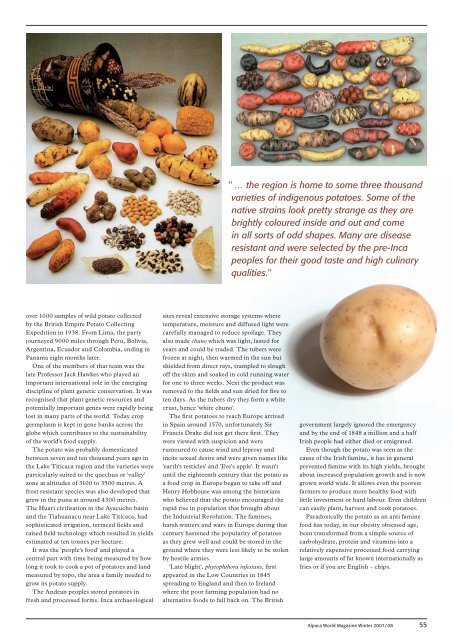Winter - Classical MileEnd Alpacas
Winter - Classical MileEnd Alpacas
Winter - Classical MileEnd Alpacas
You also want an ePaper? Increase the reach of your titles
YUMPU automatically turns print PDFs into web optimized ePapers that Google loves.
" … the region is home to some three thousand<br />
varieties of indigenous potatoes. Some of the<br />
native strains look pretty strange as they are<br />
brightly coloured inside and out and come<br />
in all sorts of odd shapes. Many are disease<br />
resistant and were selected by the pre-Inca<br />
peoples for their good taste and high culinary<br />
qualities."<br />
over 1000 samples of wild potato collected<br />
by the British Empire Potato Collecting<br />
Expedition in 1938. From Lima, the party<br />
journeyed 9000 miles through Peru, Bolivia,<br />
Argentina, Ecuador and Colombia, ending in<br />
Panama eight months later.<br />
One of the members of that team was the<br />
late Professor Jack Hawkes who played an<br />
important international role in the emerging<br />
discipline of plant genetic conservation. It was<br />
recognised that plant genetic resources and<br />
potentially important genes were rapidly being<br />
lost in many parts of the world. Today crop<br />
germplasm is kept in gene banks across the<br />
globe which contributes to the sustainability<br />
of the world's food supply.<br />
The potato was probably domesticated<br />
between seven and ten thousand years ago in<br />
the Lake Titicaca region and the varieties were<br />
particularly suited to the quechua or 'valley'<br />
zone at altitudes of 3100 to 3500 metres. A<br />
frost resistant species was also developed that<br />
grew in the puna at around 4300 metres.<br />
The Huari civilisation in the Ayacucho basin<br />
and the Tiahuanacu near Lake Titicaca, had<br />
sophisticated irrigation, terraced fields and<br />
raised field technology which resulted in yields<br />
estimated at ten tonnes per hectare.<br />
It was the 'people's food' and played a<br />
central part with time being measured by how<br />
long it took to cook a pot of potatoes and land<br />
measured by topo, the area a family needed to<br />
grow its potato supply.<br />
The Andean peoples stored potatoes in<br />
fresh and processed forms. Inca archaeological<br />
sites reveal extensive storage systems where<br />
temperature, moisture and diffused light were<br />
carefully managed to reduce spoilage. They<br />
also made chuno which was light, lasted for<br />
years and could be traded. The tubers were<br />
frozen at night, then warmed in the sun but<br />
shielded from direct rays, trampled to slough<br />
off the skins and soaked in cold running water<br />
for one to three weeks. Next the product was<br />
removed to the fields and sun dried for five to<br />
ten days. As the tubers dry they form a white<br />
crust, hence 'white chuno'.<br />
The first potatoes to reach Europe arrived<br />
in Spain around 1570, unfortunately Sir<br />
Francis Drake did not get there first. They<br />
were viewed with suspicion and were<br />
rumoured to cause wind and leprosy and<br />
incite sexual desire and were given names like<br />
'earth's testicles' and 'Eve's apple'. It wasn't<br />
until the eighteenth century that the potato as<br />
a food crop in Europe began to take off and<br />
Henry Hobhouse was among the historians<br />
who believed that the potato encouraged the<br />
rapid rise in population that brought about<br />
the Industrial Revolution. The famines,<br />
harsh winters and wars in Europe during that<br />
century hastened the popularity of potatoes<br />
as they grew well and could be stored in the<br />
ground where they were less likely to be stolen<br />
by hostile armies.<br />
'Late blight', phytophthora infestans, first<br />
appeared in the Low Countries in 1845<br />
spreading to England and then to Ireland<br />
where the poor farming population had no<br />
alternative foods to fall back on. The British<br />
government largely ignored the emergency<br />
and by the end of 1848 a million and a half<br />
Irish people had either died or emigrated.<br />
Even though the potato was seen as the<br />
cause of the Irish famine, it has in general<br />
prevented famine with its high yields, brought<br />
about increased population growth and is now<br />
grown world wide. It allows even the poorest<br />
farmers to produce more healthy food with<br />
little investment or hard labour. Even children<br />
can easily plant, harvest and cook potatoes.<br />
Paradoxically the potato as an anti famine<br />
food has today, in our obesity obsessed age,<br />
been transformed from a simple source of<br />
carbohydrate, protein and vitamins into a<br />
relatively expensive processed food carrying<br />
large amounts of fat known internationally as<br />
fries or if you are English – chips.<br />
Alpaca World Magazine <strong>Winter</strong> 2007 / 08<br />
55







